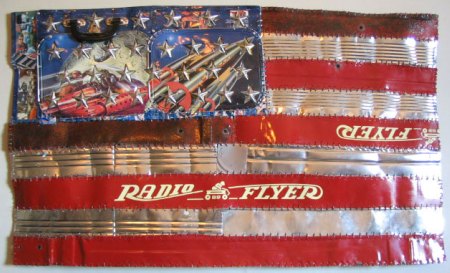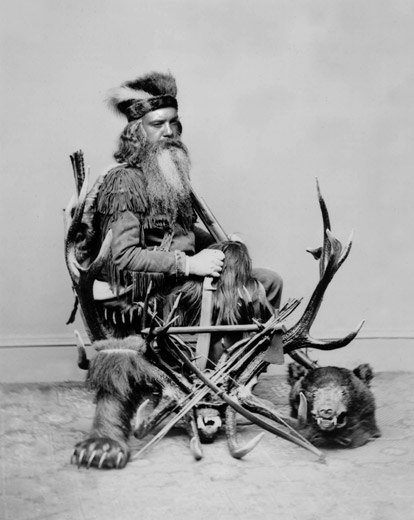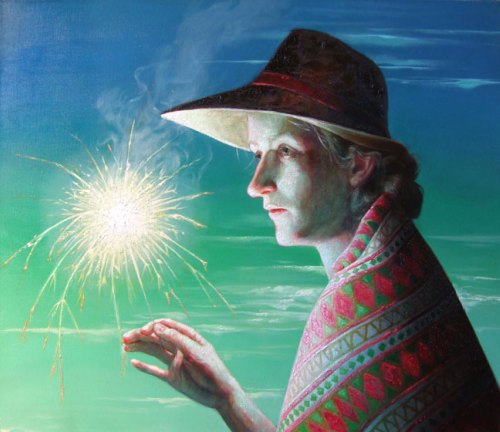Image via
Archives for July 2010
Text as art
Walter Robinson loves the smell of napalm in his car.
Forest, 2008
MDF, Epoxy, metalflake
84″ x 62″ x 1″
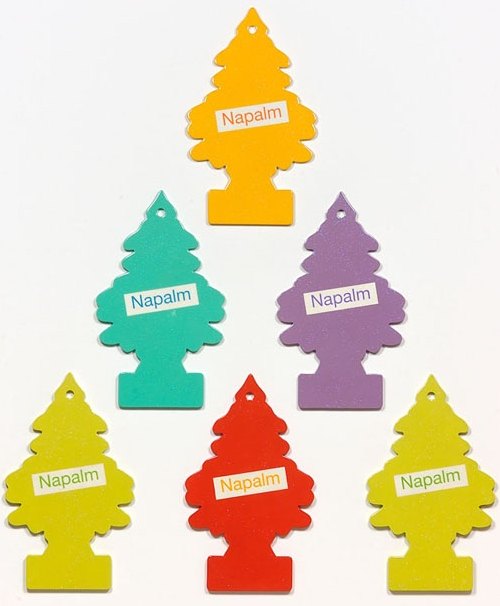 Robinson is part of Txt at the James Harris Gallery.
Robinson is part of Txt at the James Harris Gallery.
In the 1960s, Lawrence Weiner and Joseph Kosuth were key figures in the East-Coast text take-over, Ed Ruscha on the West. All advanced the idea that in visual art, text could stand alone. Today, sentence fragments, imperatives, questions and asides are more likely to serve as subject matter than a bouquet or a picnic on the grass.
Anthony Discenza
impersonates street signs. His idea of a directional assist is to point to everywhere at once.
Everything You’ve Heard, 2009
Vinyl on aluminum, Ed. of 5
24″ x 18″
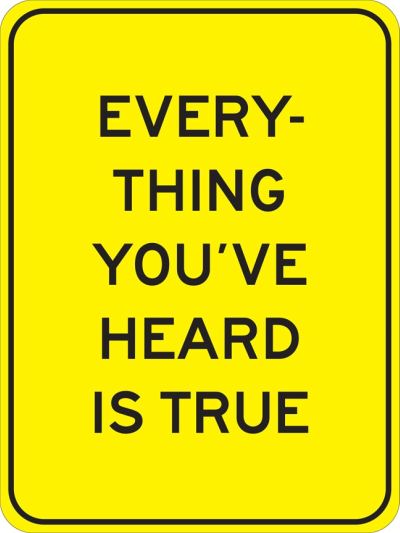 Unfamiliar Sensations, 2008
Unfamiliar Sensations, 2008
(Installation View) Vinyl on aluminum, Ed. of 5
24″ x 18″
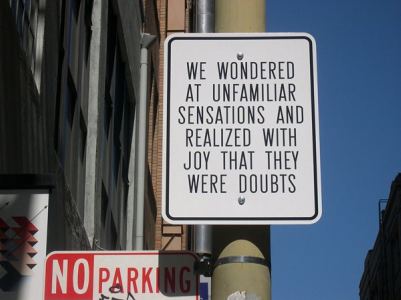 Who says the novel is dead?
Who says the novel is dead?
Matthew Buckingham Narrative, 2001
Wall Text
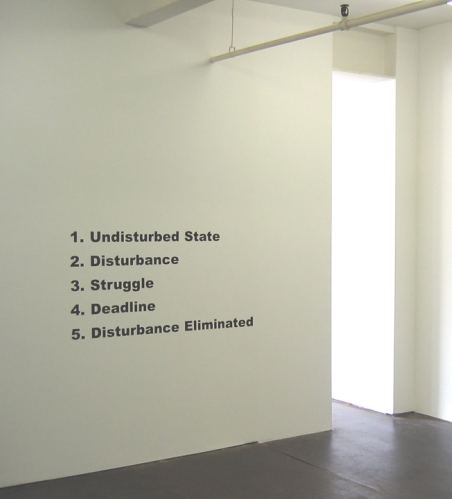 Lauren Grossman
Lauren Grossman
explores the mechanisms of blind faith
through its core imagery. Big steel birds, their feet fused into
cast-iron perches, their bodies cast in a blizzard of lettering, are emblems of fundamentalist love songs. They sing
to their own and are deaf to others.
Even Shorn, 2005
enameled cast iron, steel, rubber, brass
49″ x19″ x 21″
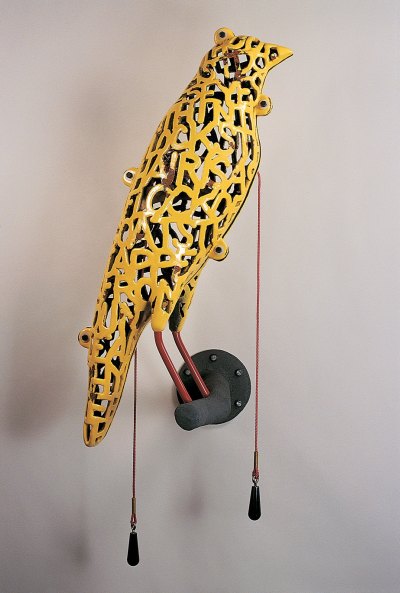 Finally, a jungle-fever designer object. (Note to the object in question: If he/she cared about you, you’d be called boyfriend, not black boyfriend.)
Finally, a jungle-fever designer object. (Note to the object in question: If he/she cared about you, you’d be called boyfriend, not black boyfriend.)
Brad Adkins
Black Boyfriend, 2006
Neon 4″ x 47″\
 Through Aug. 20.
Through Aug. 20.
On Dale Chihuly’s tide, other boats can rise
Back in December, 2007, Seattle Center announced its Fun Forest would close. Sixteen months later, Jeff Wright of the Howard S. Wright family revealed a plan for a Chihuly center near the Space Needle, funded by Wright with an initial outlay of $15 to $20 million.
How many other proposals were on the table?
None. There are eight others now, some of them excellent. None come with their own funding, which Jen Graves says is a question of timing, as the others didn’t have a “year to hone their proposal.”
This is, of course, untrue. Everybody had the same time, from late 2007. The prospect of cracked asphalt and weedy abandon was increasingly obvious to all, given the economy and the necessity of budget cuts. (More on those cuts here.) The Fun Forest was over. Given the fact that the city is struggling to mow its lawns and keep fresh water in its wading pools, what could have led anyone to suspect that the city could replace a former money-maker with a money drain?
Wednesday night, there’s a public meeting at Seattle Center’s Center House. Architects of all proposals will make their pitches from 4:30 to 6 p.m., followed by open comment.
I’ve already commented on the Chihuly plan, here and here. I’ll leave it at that, except to say the original proposal now includes additions. Wright plans to put up $1 million for the creation of artist-designed playground equipment, including fabrication and development of the site, as well as development of additional green/open space. The Chihuly team has also come up with a program to partner with Seattle Public Schools, Pilchuck Glass School, Pratt Fine Arts Center and the ArtsFund.
Team Chihuly is asking for a 5-year-lease. If the results fail to dazzle the public (and bring in from $300,000 to $500,000 annually to city coffers), its plug can be pulled, leaving the building that’s already there and a garden. (Even if he’s a raging success, the lease will terminate at 20 years.)
I’d like to see the Chihuly approved, partly because I’d also like to see one or even two of the other proposals given a chance as well. When museums sell art from their collections, best practices encourage them to use those funds to collect more art. If the city is taking in $300,000 to $500,000 from Chihuly’s project, why can’t a hefty share of that money be used to underwrite other uses of the former Fun Forest?
I’d give the nod to Open Platform and/or the Northwest Native Culture Center. The Fun Forest was 5 acres. The Chihuly center will be 1.5 acres. Math
is not my strong suit, but I believe that leaves 3.5 acres for other
uses. Think as well as, not instead of.
William Powhida’s sideshow magic
William Powhida‘s magic derives from a simple premise: If he makes fun of you, other people will laugh. (It’s art world teeter-totter. Your stock goes down, his rises.) Seattle has its own version. Instead of a smart-aleck upstart, Seattle has an old grump. When the old grump (critic Matthew Kangas) visited Powhida and Eric Trosko‘s exhibit at Platform Gallery, Magicality, dealer Stephen Lyons visibly braced himself.
Kangas started with what appeared to be a compliment, congratulating Lyons for packing the space. As Kangas is aware, that praise needs to go to the curators. Left to his own devices, Lyons favors spare. Kangas was born too late for salon style but does his best to revive it. Moving into the back room, he looked down on a group of Jaq Chartier’s small paintings lying on top of a table. “Are these trivets?” he asked.
Chartier 7 Stain Lines
2009, 6 x 6 inches
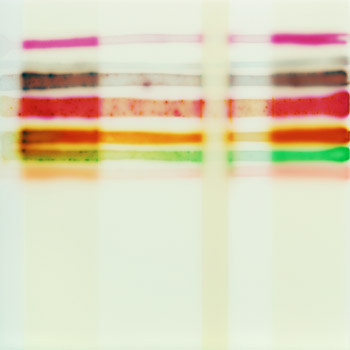 Lyons was not amused, but as Powhida’s Seattle dealer, he chuckled over the drawing reproduced below, a visual rant on the abilities of painter Dana Schutz. Powhida followed with a hex on her dealer, Zach Feuer, who took neither sally lying down. (Powhida told Jen Graves it was “like hooking a shark.” )
Lyons was not amused, but as Powhida’s Seattle dealer, he chuckled over the drawing reproduced below, a visual rant on the abilities of painter Dana Schutz. Powhida followed with a hex on her dealer, Zach Feuer, who took neither sally lying down. (Powhida told Jen Graves it was “like hooking a shark.” )
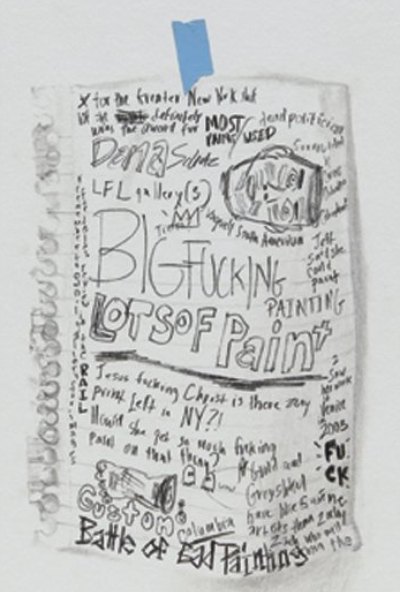 Powhida takes pains to point out that he is not William Powhida, the heckoring voice in his frantic yet silky drawings. No, outside his studio, he’s a mild-mannered high school art teacher, friend to all creatures great and small. As he told David Goodman:
Powhida takes pains to point out that he is not William Powhida, the heckoring voice in his frantic yet silky drawings. No, outside his studio, he’s a mild-mannered high school art teacher, friend to all creatures great and small. As he told David Goodman:
In my studio, I am trying to capitalize on controversy, by challenging the establishment. The other day, a small group of seniors were discussing the yearbook. They didn’t want to include the other grades because they wanted the yearbook to only be about them. Listening to them, I could hear that demanding, entitled voice that comes through in my drawings–the one that only wants to satisfy his desires. In my art, I grapple with that attitude encountered as an artist. The drawings, specifically my letters, work on two levels: a ridiculous self-assurance, I’m a genius; and a pathetic, needy voice who might just need a hug.
Powhida’s art world is a corrupt carnival show. Now that he’s in the ring, he’s as worried as any bearded lady about losing his spot. That spot depends upon his edge, and applause from his targets blunts it. If he calls the ringmaster a clown and the ringmaster pats him on the back, who’s the clown? Not the ringmaster, who’s in on the joke.
The search for a new target brings us Magicality. The spirit of high-school teachers hovers over the premise, which compares/contrasts religious artifacts with artworks. Were Powhida and Trosko really in the classroom, they’d let the students reach their own conclusions. Because the curators are in a gallery, however, they need spoon feed the audience the manifesto. It’s available in leaflet form at the front door in the hopes somebody might pick it up as they exit and give it a glance while rooting around for change to feed the meter.
We desire to illuminate and challenge the parallels between the disciplines of art and magic(k). Both disciplines share belief systems that rely on a priori knowledge and metaphysics. In order to explore the parallels, we have sought out artifacts of practices rather than traditional art works. The difference between an artifact and an art work is dependent on our perception of an illusion or delusion…
Nontraditional in this case means unlikely to sell. In the art world, of course, unsalable is a moving target. Seek it out, it proves elusive. Avoid it, and you hand your dealer a storage problem. I feel confident, however, that Trosko’s amulets will be available for him to pick up at the show’s conclusion. Well done, Mr. Trosko!
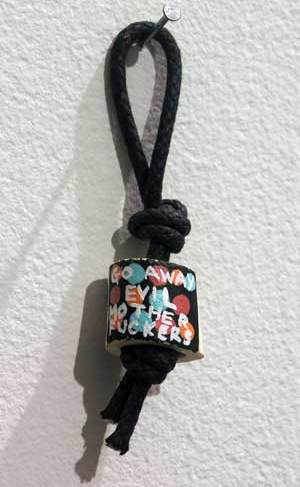 As far as Powhida’s fare, there’s nothing here I haven’t seen before.
As far as Powhida’s fare, there’s nothing here I haven’t seen before.
New target, old hex:
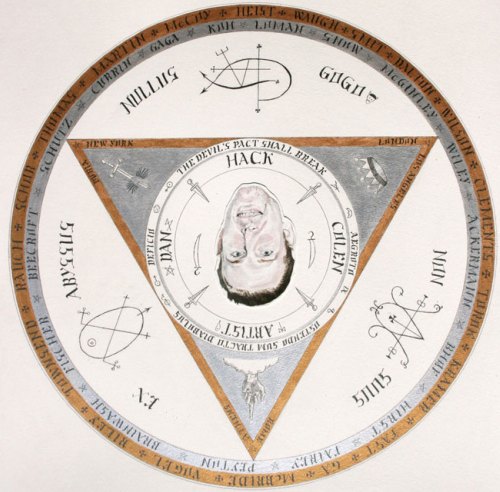 Powhida has an answer for this crass, what-have-you-done-for-me lately critique: (via)
Powhida has an answer for this crass, what-have-you-done-for-me lately critique: (via)
My intention is to critique how the art market consumes people and turns them into commodities to be traded. I’d like to think my work will be remembered because it calls attention to that system, more than cementing the reputations of these artists. You can look back through issues of Artforum and not recognize any of the artists. As Jerry Saltz has said, the art world eats it’s young.
There are a few pieces in the show that work, whether they’re called hexes, exorcisms or art. Congratulations to Letha Wilson for her anti-bombast, pseudo-sublime:
Wilson, Right Back at You
Digital C-print, flashlight, rocks, 42 x 30 x 46 inches, 2009
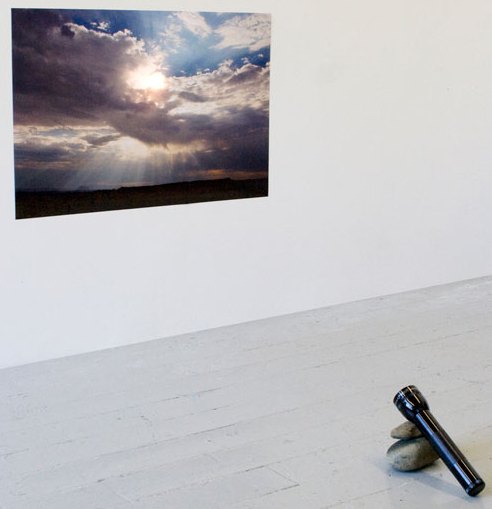 Jade Townsend’s house has a nursery-rhyme appeal: Here is the church, here is the steeple. Open the doors and out come the people (BOOM).
Jade Townsend’s house has a nursery-rhyme appeal: Here is the church, here is the steeple. Open the doors and out come the people (BOOM).
Wilson, Of Alchemy, Dreams and Revolution; Ticking Like A Fucking Bomb Brick
Gold krylon, lauan, wiggle board, ultralite, black bandanas, balsa foam, white latex primer, flat white krylon and paint marker, 16 x 11 x 18 inches, 2007, Courtesy Priska C. Juschka Fine Art
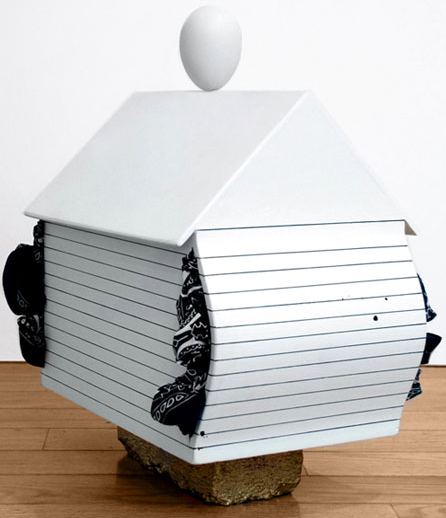 Other surprises? I was surprised that Powhida’s exorcism in chalk was still largely unsmudged on the floor nearly a week after the opening. People tiptoe around it as if it were a sacred thing. Its target is Dale Chihuly’s project at Seattle Center. Note to Powhida: There is such a thing as being a little bit too hip.
Other surprises? I was surprised that Powhida’s exorcism in chalk was still largely unsmudged on the floor nearly a week after the opening. People tiptoe around it as if it were a sacred thing. Its target is Dale Chihuly’s project at Seattle Center. Note to Powhida: There is such a thing as being a little bit too hip.
No one can say the same about Matthew Kangas. Month in and out, he attends nearly every gallery in Seattle and manages to invent fresh ways to insult the dealers. He’s their cross to bear. The rest of us are just too fucking nice.
The hat makes the man
Kenneth Josephson Chicago 1964
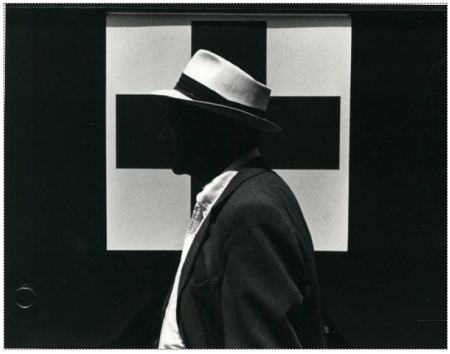 Steve Davis Fred from RAINIER SCHOOL
Steve Davis Fred from RAINIER SCHOOL
Home for Developmentally
Disabled 2005-2006
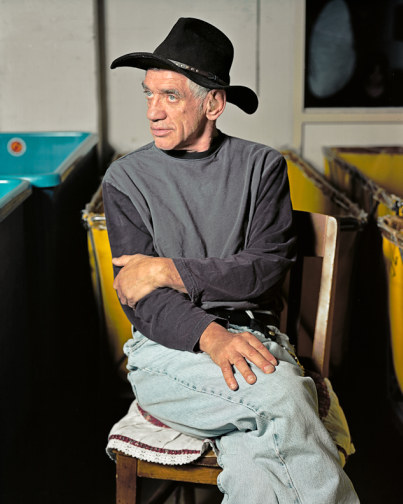 Oliver Jackson Untitled (7.21.03), 2003
Oliver Jackson Untitled (7.21.03), 2003
Water-based pigments and silver leaf on unprimed cotton canvas, 65 x 64-1/2 in.
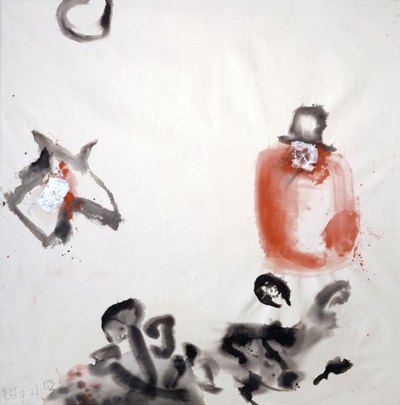 Grant
Grant
Barnhart Voorbereiding voor de Dreigende Zwerm
11×14, Acrylic on canvas (2009)
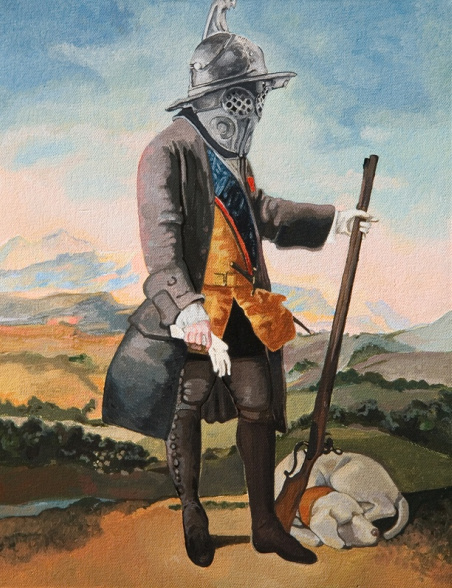 Justin Colt Beckman Untitled
Justin Colt Beckman Untitled
digital collage of the artist’s face on found photo, 2008
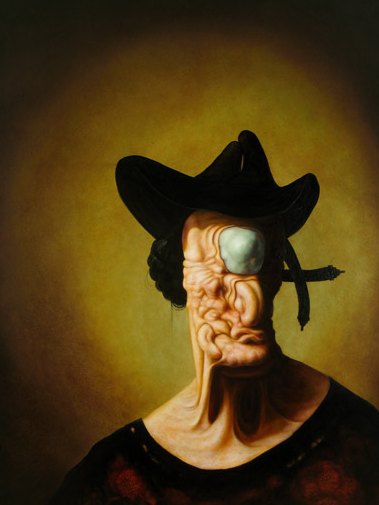 Akio Takamori Sea Serpent, 2009
Akio Takamori Sea Serpent, 2009
Digital Inkjet Print and Lithography Ed. of 35
41 1/2 ” x 26″
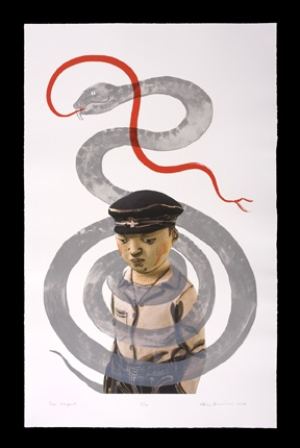 Matt Browning Honest Labor Pt. II, 2008
Matt Browning Honest Labor Pt. II, 2008
Bicycle, bicycle trainer, wood, car alternator,
battery, inverter, extension cord, refrigerator
Dimensions variable
(One night performance)
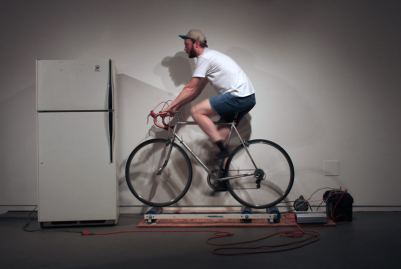 Buddy Bunting 2007, ink and pencil on paper, 5.5 x 6.25 in
Buddy Bunting 2007, ink and pencil on paper, 5.5 x 6.25 in
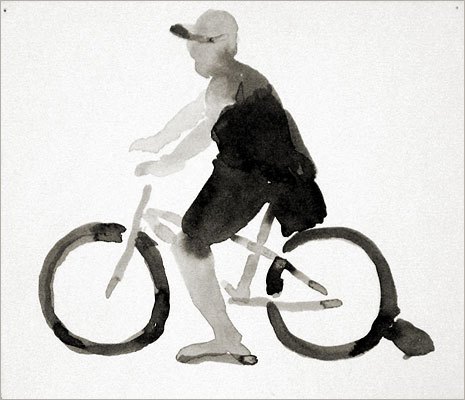 Chris Crites Mugshots, Burglary 9″w x 10.5″h
Chris Crites Mugshots, Burglary 9″w x 10.5″h
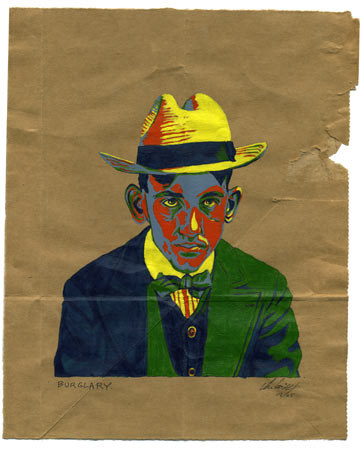 Jack Daws VIVA ZAPATA, 2007
Jack Daws VIVA ZAPATA, 2007
Plastic tub, acrylic on aluminum, lacquer
18 x 16 x 22 inches
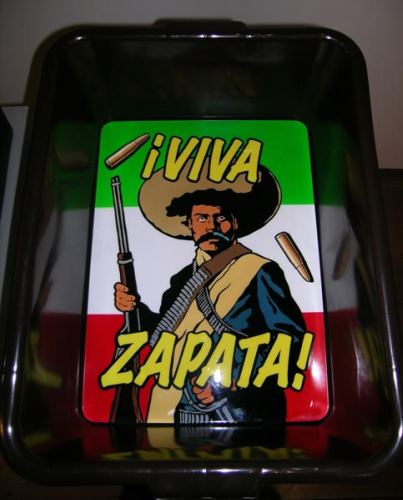 Roger Shimomura ETERNAL FOREIGNER #8, 2006
Roger Shimomura ETERNAL FOREIGNER #8, 2006
Acrylic on canvas
60 x 18 inches
 SuttonBeresCuller Duwamish II, 2009
SuttonBeresCuller Duwamish II, 2009
Photograph face-mounted to acrylic
24 x 16 inches
Edition of 7 + 2 A.P.
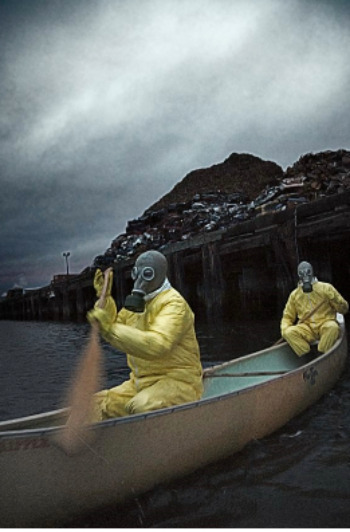
Your need to see darkly
Alexander Binder is prepared to fill it. (Via)
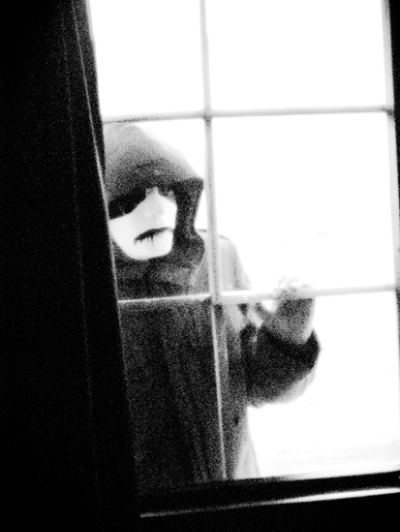
For those who partied alone…
Two images.
“I am lonely, lonely.
I was born to be lonely,
I am best so!”
from Danse Russe, William Carlos Williams
Marx and the limitation of circumstances
Marx, from The Eighteenth Brumaire of Louis Bonaparte, 1852:
Men
make their own history, but they do not make it as they please; they
do not make it under circumstances of their own choosing, but under
circumstances existing already, given and transmitted from the past.
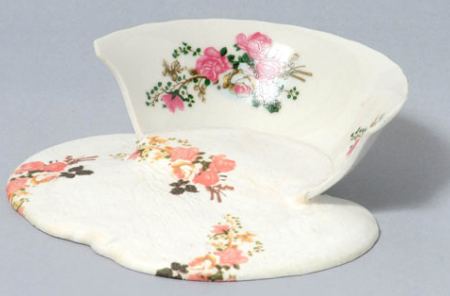
Without fanfare, Sam Francis leaves Seattle
Across the street from Rem Koolhaas’ Seattle Central Library is an
anonymous corporate building whose courtyard long sported incongruously
heavy-duty art credentials.
On the southwest corner is Henry Moore’s Vertebrae from 1968, in place since 1971.
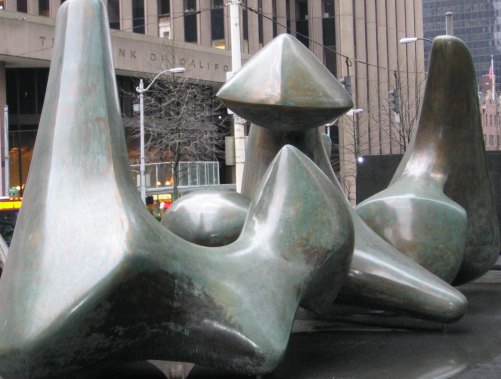 Behind and just north of Vertebrae a large acrylic abstraction by Sam Francis hung in the building’s lobby, fully visible from the street. It’s a grid undermined by splatters of colored light, 18.8 feet high and 26.6 feet wide, created in 1979 and purchased in 1980.
Behind and just north of Vertebrae a large acrylic abstraction by Sam Francis hung in the building’s lobby, fully visible from the street. It’s a grid undermined by splatters of colored light, 18.8 feet high and 26.6 feet wide, created in 1979 and purchased in 1980.
It’s gone now. Bank of America, its current owners, alerted nobody but the building’s tenants. Even they got only two days notice. This email arrived in their collective mailboxes on June 24 from Carsten Stehr, portfolio manager- NW Corporate Workplace,
Bank of America:
We wanted to make you aware that on June 26th, the Sam Francis painting
located in the lobby will be permanently removed to become part of the
bank’s Art in our Communities program and will initially be loaned to
the Mint Museum of Art in Charlotte, NC in conjunction with a large
exhibition of contemporary art from the bank’s collection.
The Francis is a last-minute addition at the Mint. On its website, the Mint doesn’t mention it. Stehr didn’t return several phone calls, but Britney Sheehan, media relations for the bank, did. She noted that instead of occupying several floors of the building, BofA is now limited to part of the lobby. Aside from joining the bank’s exhibit at the Mint, Francis’ painting has nothing else inked on its dance card. I asked Sheehan for an image. The next day, we had the following exchange.
Sheehan: We don’t have an image.
Me: You’ve owned the painting since 1980 and don’t have an image?
Sheehan: Yes.
Me: You can tell me that you won’t send me one, but you shouldn’t say you don’t have one. It isn’t believable.
Sheehan: An image is not available.
Below, a bad image from Google Earth:
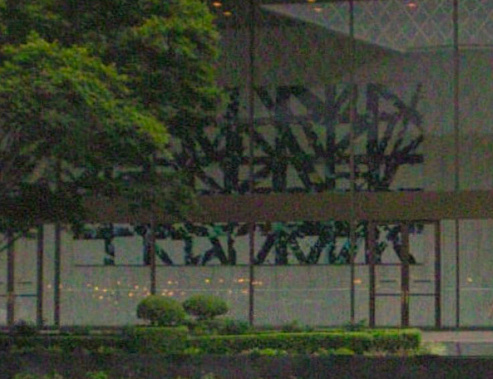 The bank has good reason for not wanting to share. In 1986, Seafirst Bank and JMB Management Company admitted that they had sold Vertebrae to a private collector in Japan. Both Seafirst and JMB were swamped by angry calls.
The bank has good reason for not wanting to share. In 1986, Seafirst Bank and JMB Management Company admitted that they had sold Vertebrae to a private collector in Japan. Both Seafirst and JMB were swamped by angry calls.
Linda Farris and David Mendoza organized protest marches and petitions. (“Henry Moore, he’s our man, we don’t want him to go to Japan.”) Unfavorable press coverage (largely from me) broke out of the arts section and began appearing on the front page. The city stepped in, blocking the sculpture’s removal on a technicality
(work permits were not in order).
After 8 tons of bad publicity over a two-month period, JMB and Seafirst
gave the Seattle Art Museum the money (twice the $1 million they’d received)
to buy back the sculpture from its new owner and guarantee it a
permanent Seattle home.
Will the Francis be sold after its star turn at the Mint? Nobody’s saying. Sheehan emphasized that the bank continues to support the arts in Seattle. She said in 2009 it donated $300,000 to arts in Seattle and Bellevue. In the last 10 years, she noted it has donated $900,000 to ArtsFund.
That’s an admirable past, but the loss of the Francis is a doleful comment on the future.
Flags for the Fourth
On the admirable Pacific Standard blog, Strath posted a range of old glories in honor of the Fourth. Below, a few of my lesser-known favorites (beyond Jasper Johns and David Hammons). Also, check out Tyler Green’s flag survey on BuzzFeed.
Meiro Koizumi at Open Satellite:
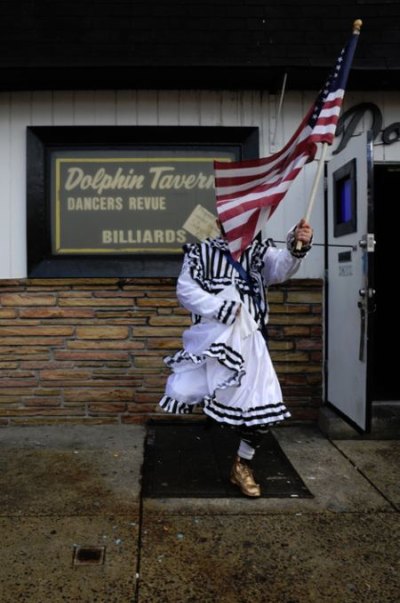 Jack Daws, three times
Jack Daws, three times
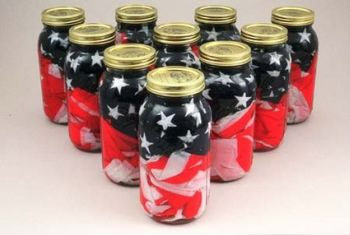
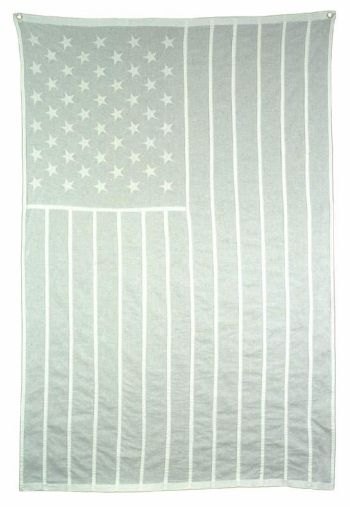
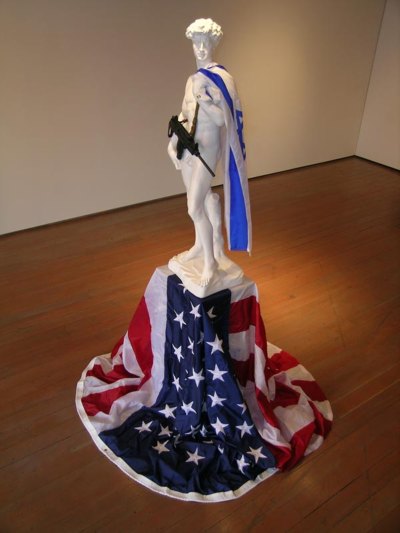 Ross Palmer Beecher, two times
Ross Palmer Beecher, two times

